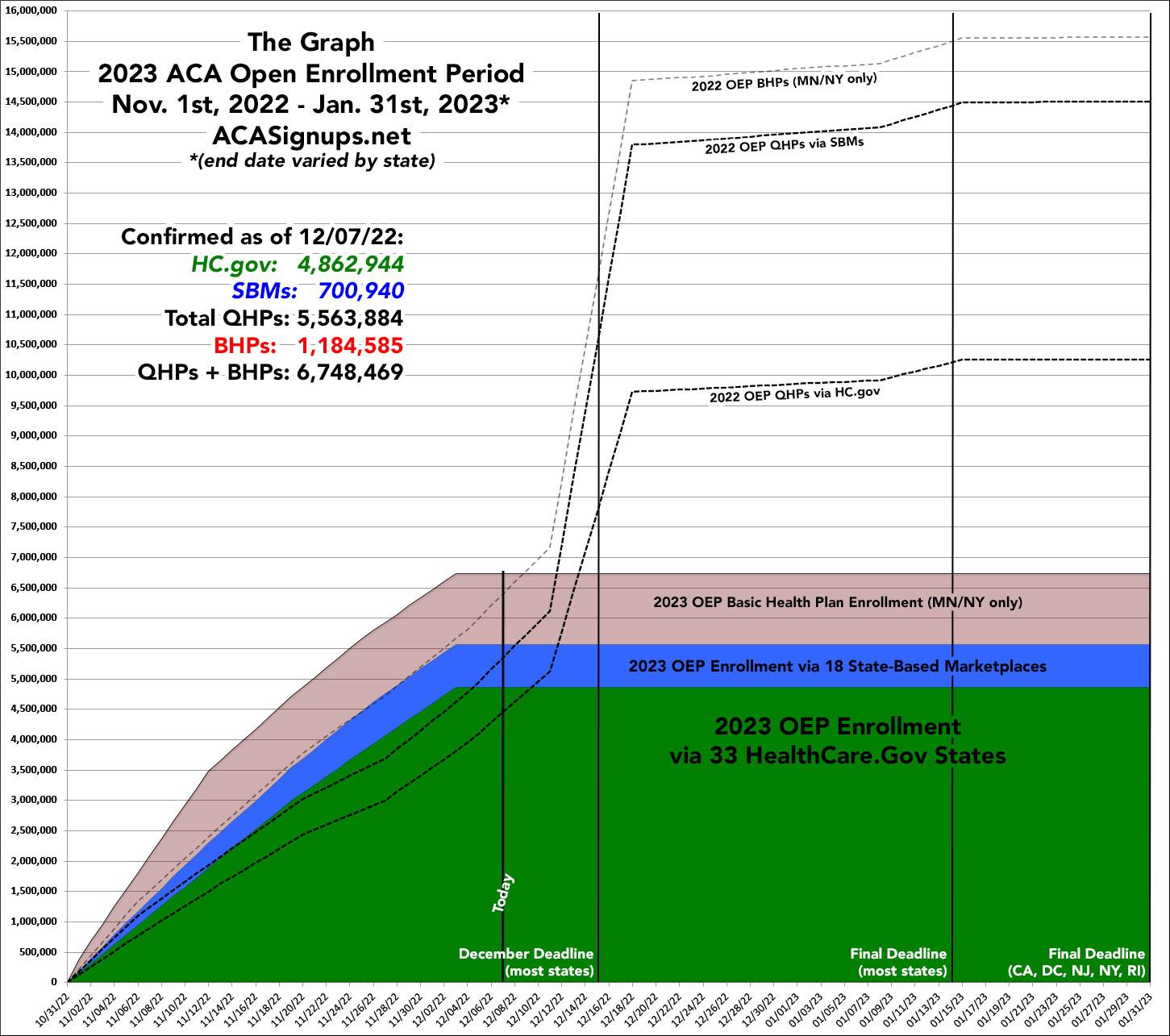BOOM: 2023 Open Enrollment Period breaks 6.8M; QHP enrollment up 18% y/y!

via the Centers for Medicare & Medicaid Services:
- Plan selections represent an 18% increase over last year, including 1.2 million enrollees who are new to the Marketplace
ACA Marketplace National Enrollment Snapshot
The Biden-Harris Administration announced today that Affordable Care Act (ACA) Marketplace enrollment continues to move at a fast pace--nearly 5.5 million people have selected an Affordable Care Act (ACA) Marketplace health plan nationwide since the start of the 2023 Marketplace Open Enrollment Period (OEP) on November 1. This represents activity through December 3, 2022 (Week 5) for the 33 Marketplaces using HealthCare.gov and through November 26, 2022 (Week 4) for the 18 State-based Marketplaces (SBMs) in 17 states and the District of Columbia. Total plan selections include 1.2 million people (22% of total) who are new to the Marketplaces for 2023, and 4.3 million people (78% of total) who have active 2022 coverage and returned to their respective Marketplaces to renew or select a new plan for 2023. The 5.5 million total plan selections represent an 18% increase from 4.6 million this time last year.
Once again, for some inexplicable reason, CMS continues to relegate Basic Health Plan (BHP) enrollment in New York and Minnesota to a literal footnote:
[2] In addition to reported plan selections, New York and Minnesota have a Basic Health Program (BHP), which provides coverage to consumers with household incomes up to 200 percent of the FPL who are not eligible for Medicaid or CHIP and otherwise would be eligible for a QHP. From November 1 – November 26, 2022, New York had a total of 1,082,235 individuals enroll in a BHP. Minnesota’s BHP data was not available at the time of this report.
...except that according to the Minnesota Dept. of Human Services, MinnesotaCare (BHP) enrollment is 102,350 for December. In addition, I have a few SBM enrollment reports which are more recent than today's CMS press release.
Add the BHP enrollees and these oddball SBM updates to the total and you actually get a grand total of 6,748,489.
In fact, it's even higher than that--remember, the other SBM enrollment numbers as well as NY BHP enrollment are only as of 11/26. Actual enrollment nationally as of today is likely over 7.5 million, but I don't have hard data for that yet.
UPDATE: Both Colorado and Nevada released updated enrollment data today as well, bringing the confirmed grand total up to at least 6,838,681 QHP + BHP selections combined.
The 2023 Marketplace OEP runs from November 1, 2022 to January 15, 2023 for Marketplaces using the HealthCare.gov platform. People generally need to submit an application and choose a plan by December 15 for their coverage to start January 1. State-based Marketplace enrollment deadlines vary. State-specific deadlines and other information are available in the State-based Marketplace Open Enrollment Fact Sheet.
“We are off to a strong start - and we will not rest until we can connect everyone possible to health care coverage this enrollment season,” said HHS Secretary Xavier Becerra. “The Biden-Harris Administration has taken historic action to expand access to health care, and ensure everyone can have the peace of mind that comes with being insured. With four out of five people eligible for coverage at $10 or less, do not miss your opportunity to sign up for high-quality, affordable health care. We urge everyone to visit HealthCare.gov and find the coverage that meets your needs.”
“Providing quality, affordable health care options remains a top priority. We are incredibly pleased to see continued strong enrollment numbers in this second snapshot report, especially the increase in new enrollees. We are going to keep our focus on ensuring that all who seek health care coverage get the affordable, quality coverage they need,” said CMS Administrator Chiquita Brooks-LaSure. “I encourage all those looking for affordable health care, or interested in exploring their options, to visit HealthCare.gov before the December 15 deadline for their coverage to begin on January 1.”
The Biden-Harris Administration has made expanding access to health insurance and lowering health care costs for America’s families a top priority, and under their leadership, the national uninsured rate reached an all-time low earlier this year.
The Biden-Harris Administration encourages all families to visit HealthCare.gov and check out the health care coverage options and savings available to them. This year, thanks to the Inflation Reduction Act, more people will continue to qualify for help purchasing quality health coverage with expanded financial assistance. Four out of five HealthCare.gov enrollees will be able to find a plan for $10 or less after tax credits. People with coverage through HealthCare.gov are encouraged to return and shop to see if another plan better meets their needs at a lower cost.
Individuals will also benefit from a highly competitive Marketplace. Ninety-two percent of HealthCare.gov enrollees will have access to options from three or more insurance companies when they shop for plans. Also, new standardized plan options are available in 2023 through HealthCare.gov, which offer the same deductibles and cost-sharing for certain benefits, and the same out-of-pocket limits as other standardized plans within the same health plan category, to help consumers compare and select plans. Most of these standardized plan options offer many services pre-deductible, including primary care, generic drugs, preferred brand drugs, urgent care, specialist visits, mental health and substance use outpatient office visits, as well as speech, occupational, and physical therapy.
Individuals can enroll or re-enroll in health insurance coverage for 2023 by visiting HealthCare.gov, or CuidadoDeSalud.gov, or by calling 1-800-318-2596 to fill out an application.
Individuals wanting assistance signing up for coverage may go to Find Local Help on HealthCare.gov to find a Navigator, Certified Application Counselor, or agent or broker.
Here's the state-by-state breakout compared to the same point (minus one day) last year. Remember that the 18 SBM states are only through 11/26 (11/27 last year) while the HC.gov states are as of 12/03 (12/04 last year):
There's 7 states where 2023 Open Enrollment is up by 30% or more compared to the same point last year: New Jersey, Mississippi, Louisiana, South Carolina, Texas, Tennessee and Idaho...the latter of which is up a whopping 70% y/y. Without knowing the state-level breakout of new enrollees vs. active renewals, however, it's difficult to draw any solid conclusions yet, since it could just be a matter of Your Health Idaho moving more aggressively to get current enrollees to actively renew/shop around for their 2023 coverage. In fact, it's probably mostly due to YHI launching their 2023 OEP two weeks early this year.
At the same time, there's 6 states with double-digit enrollment declines so far, all of which are state-based exchanges: New York is down 40%, while Pennsylvania, California, Maine, DC and Vermont are all down between 11 - 23%. Again, however, some of this may be due to strategy shifts re. active renewals; I'd have to know how many new enrollees have signed up in each state to draw any real conclusions so far.
Here's a national comparison of the new vs. returning enrollment breakout year over year for both HC.gov states, SBM states and the combined total. Note that the "as of 12/04/21" numbers from last year are slightly lower than the state-by-state numbers in the table above, presumably due to some data cleanup done by CMS after they posted this press release a year ago.
The total y/y increase shows up as being 19.4% instead of 17.9% due to the slight data mismatch from last year. NEW enrollment is up over 28% so far while active renewals are up 17% nationally.
For HealthCare.Gov states only, new enrollment is up nearly 32% & returning enrollees are up 21%. State-based exchanges are down 4.3%, however, with that mostly being due to current enrollees being slower to return to the exchange to actively renew their plan (or choose a different one).







